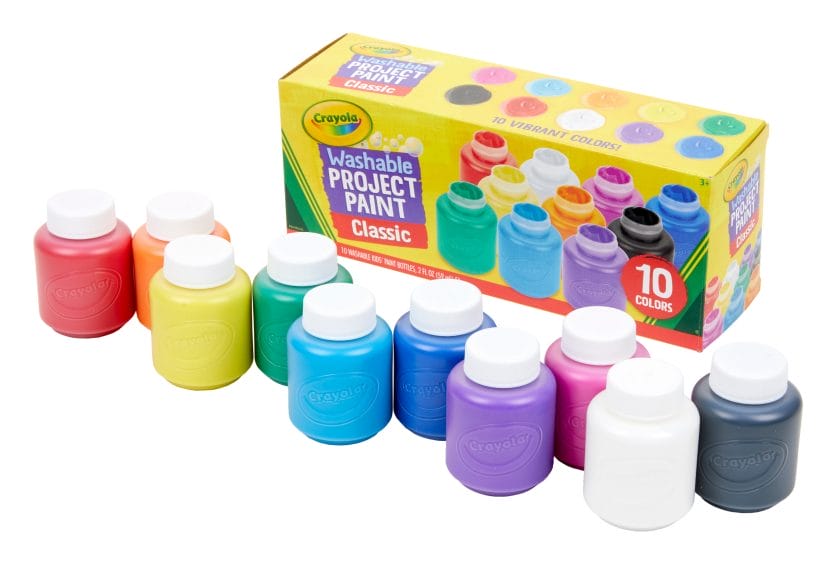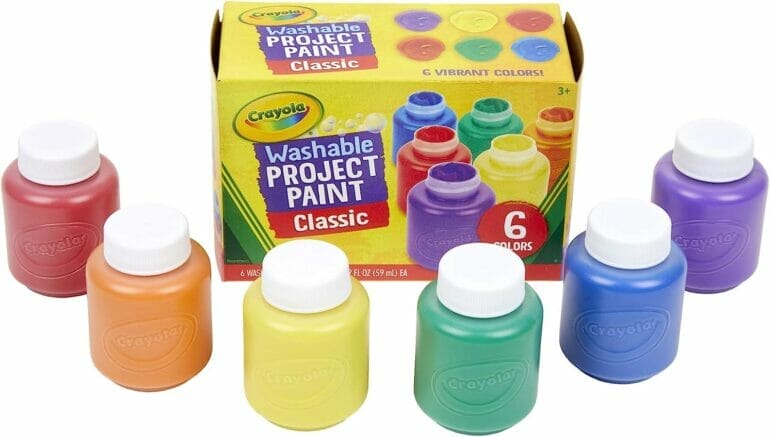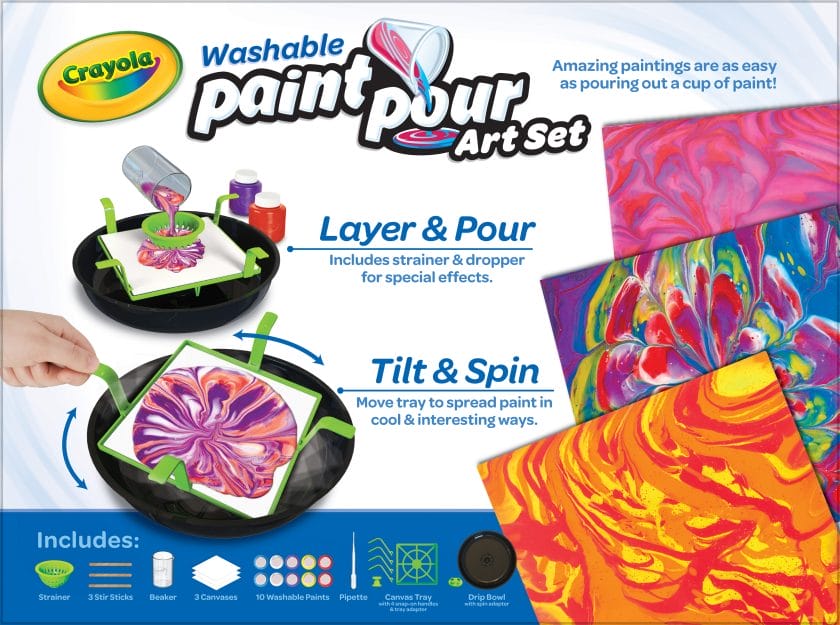Are you wondering if Crayola Washable Paint is acrylic? Well, the answer is no. Crayola Washable Paint is not acrylic paint. It is a water-based paint that is specially formulated to be easy to clean and washable from most surfaces. Crayola Washable Paint is a popular choice for kids’ crafts and art projects, as it allows for easy clean-up and offers vibrant, non-toxic colors. So, if you’re looking for a mess-free and washable paint option, Crayola Washable Paint is a great choice!

1. Understanding the Difference: Crayola Washable Paint vs. Acrylic Paint
When it comes to choosing the right type of paint for your art projects, it’s important to understand the differences between various options. Two popular choices are Crayola Washable Paint and acrylic paint. While they may seem similar at first glance, there are several key distinctions that set them apart.
1.1 Crayola Washable Paint
Crayola Washable Paint is a water-based paint that is specifically designed for children. It is known for its vibrant colors and easy washability, making it a favorite among parents and teachers alike. This type of paint is non-toxic and can be easily cleaned off surfaces, making it ideal for messy art projects.
Crayola Washable Paint comes in a variety of forms, including bottles, jars, and even washable markers. It is easy to use, as it can be applied with brushes, sponges, or even fingers. This makes it a great option for young children who are just starting to explore their artistic abilities.
1.2 Acrylic Paint
Acrylic paint, on the other hand, is a type of paint that is commonly used by both professional artists and hobbyists. It is made from pigment suspended in an acrylic polymer emulsion, which gives it a smooth consistency and allows it to dry quickly.
Acrylic paint is known for its versatility and durability. It can be used on a wide range of surfaces, including canvas, wood, metal, and even plastic. It is also available in a wide range of colors and finishes, from matte to glossy. Acrylic paint is known for its long-lasting properties, making it a popular choice for creating art pieces that will stand the test of time.
One of the advantages of acrylic paint is its ability to be layered and blended. This allows artists to create a wide range of effects and textures in their work. Additionally, once acrylic paint dries, it becomes water-resistant, which means it can be used in outdoor projects and will not easily wash away.
1.3 Key Differences
While both Crayola Washable Paint and acrylic paint are used for art projects, there are several key differences between the two:
- Crayola Washable Paint is designed for children and is non-toxic, while acrylic paint is used by artists of all ages and may contain chemicals.
- Crayola Washable Paint is easily washable, while acrylic paint becomes water-resistant when dry.
- Acrylic paint offers a wider range of colors and finishes compared to Crayola Washable Paint.
- Acrylic paint can be used on a variety of surfaces, while Crayola Washable Paint is primarily used on paper and other porous materials.
- Acrylic paint can be layered and blended to create various textures and effects, while Crayola Washable Paint is limited in its versatility.
In summary, while Crayola Washable Paint is a great choice for young children and messy art projects, acrylic paint offers more versatility and durability for artists of all ages. Understanding the differences between these two types of paint can help you make an informed decision when choosing paint for your next art project.
Advantages of Crayola Washable Paint for Art Projects
Art projects are a great way for children to express their creativity and explore their imaginations. However, they can also be messy, especially when it comes to using paint. That’s where Crayola Washable Paint comes in. With its unique features and benefits, Crayola Washable Paint offers a convenient and hassle-free painting experience for both kids and parents. Let’s explore some of the advantages of using Crayola Washable Paint for art projects.
1. Easy to Clean
One of the major advantages of Crayola Washable Paint is its ease of cleaning. Unlike traditional paints, Crayola Washable Paint can be easily washed off from skin and most washable clothing. This means that parents don’t have to worry about permanent stains or spending hours scrubbing their child’s skin after a painting session. Simply use soap and water, and the paint will come off effortlessly.
2. Non-Toxic and Safe
Crayola Washable Paint is formulated to be non-toxic and safe for children to use. It is made from high-quality, non-hazardous materials that are certified as safe for children. This makes Crayola Washable Paint an ideal choice for art projects, as parents can have peace of mind knowing that their child is using a safe and non-toxic product.
3. Vibrant Colors
When it comes to art projects, vibrant colors can make all the difference. Crayola Washable Paint offers a wide range of vibrant colors that can bring any artwork to life. Whether it’s a bold red or a soothing blue, Crayola Washable Paint provides rich and vibrant hues that can inspire creativity and imagination.
4. Versatility
Crayola Washable Paint is incredibly versatile and can be used on various surfaces, including paper, cardboard, wood, and more. This allows children to explore different mediums and experiment with different techniques. Whether they’re painting a canvas, creating a masterpiece on a piece of cardboard, or decorating a wooden craft, Crayola Washable Paint provides the flexibility and adaptability needed for any art project.
5. Easy to Use
Crayola Washable Paint is designed to be user-friendly, especially for young artists. The paint has a smooth and creamy consistency, making it easy to apply and blend. It also dries quickly, allowing children to add multiple layers or continue working on their artwork without waiting for long drying times. The easy-to-use nature of Crayola Washable Paint makes it suitable for children of all skill levels.
6. Affordable
Art supplies can often be expensive, especially when it comes to quality paints. However, Crayola Washable Paint offers an affordable option without compromising on quality. The paint is reasonably priced, making it accessible for both schools and parents who are on a budget. With Crayola Washable Paint, children can enjoy the benefits of high-quality paint without breaking the bank.
In summary, Crayola Washable Paint is a top choice for art projects due to its easy cleaning, non-toxic formulation, vibrant colors, versatility, user-friendly nature, and affordability. When it comes to creating beautiful artworks without the mess and worry, Crayola Washable Paint is the ideal option for young artists.
Exploring the Versatility of Acrylic Paint for Artists and Crafters
Acrylic paint is a popular medium used by artists and crafters alike. It offers a wide range of benefits, including its versatility and ease of use. In this section, we will explore the various ways acrylic paint can be utilized to create stunning artworks and craft projects.
1. Painting on Canvas
One of the most common uses of acrylic paint is for painting on canvas. Acrylics have a smooth consistency that allows for easy blending and layering, making them perfect for creating vibrant and detailed paintings. Whether you are a beginner or an experienced artist, acrylic paint on canvas offers endless possibilities for expressing your creativity.
2. Mixed Media Art
Acrylic paint can be easily combined with other materials to create mixed media art. You can incorporate collages, papers, fabrics, and found objects into your artwork, adding texture and depth. The fast-drying nature of acrylics allows you to layer different materials without waiting for extended periods, making it an ideal choice for mixed media projects.
3. Decorative Crafts
Acrylic paint is not just for canvas and paper; it can also be used to transform various objects into beautiful decorative pieces. From wooden furniture and ceramic pots to glassware and even fabrics, acrylic paint adheres well to a variety of surfaces, giving you the freedom to personalize and revamp your home decor items.
4. Fluid Art
Fluid art, also known as acrylic pouring or pour painting, is a technique that involves pouring acrylic paint onto a canvas or other surfaces. The paint is then manipulated to create mesmerizing patterns and designs. This experimental and unpredictable method of painting can produce stunning abstract artworks that are full of movement and color.
5. Textured Effects
With the help of various tools and additives, acrylic paint can be used to achieve a wide range of textured effects. Whether you want to create rough and gritty surfaces or smooth and glossy finishes, there are countless techniques to explore, such as impasto, sgraffito, and glazing. These techniques allow artists and crafters to add interest and dimension to their creations.
6. Outdoor Art
Unlike some other paints, acrylics are water-resistant once they dry, making them suitable for outdoor use. Whether you want to create murals, paint on rocks, or decorate garden ornaments, acrylic paint is durable and long-lasting, making it perfect for withstanding various weather conditions.
7. Customizing Personal Belongings
Acrylic paint provides an excellent way to personalize and customize your personal belongings. Whether it’s painting designs on clothing and shoes, creating unique phone cases, or even designing your own colorful accessories, acrylic paint allows you to unleash your creativity and make your belongings one-of-a-kind.
8. Teaching Tool
Acrylic paint is often used as a teaching tool in art classes and workshops. Its versatility and ease of use make it an ideal medium for beginners to learn and experiment with different painting techniques. Additionally, acrylics are relatively affordable compared to other paints, making them accessible to a wider audience.
In summary, acrylic paint is a versatile medium that offers a wide range of opportunities for artists and crafters. Whether you prefer painting on canvas, experimenting with mixed media, creating decorative crafts, or exploring unique techniques, acrylic paint provides endless possibilities to unleash your creativity. Its ease of use, fast-drying properties, and ability to adhere to various surfaces make it a favorite among artists and crafters alike.
Comparing the Durability and Longevity of Crayola Washable Paint and Acrylic Paint
When it comes to choosing the right paint for your art projects, durability and longevity are important factors to consider. In this section, we will compare the durability and longevity of Crayola Washable Paint and Acrylic Paint to help you make an informed decision.
Durability
Crayola Washable Paint is specifically designed for children and is known for its washability. It is water-based and can easily be washed off from skin, fabric, and surfaces with soap and water. While it is great for young artists, the washability of Crayola Washable Paint may compromise its durability. It is not as resistant to fading, cracking, or peeling as other types of paint.
On the other hand, Acrylic Paint is known for its durability. It is made with a polymer emulsion that dries to a flexible and water-resistant finish. Acrylic Paint is highly resistant to fading, cracking, and peeling, making it a popular choice for professional artists. It can withstand various environmental conditions and is suitable for both indoor and outdoor use.
Overall, if durability is your main concern, Acrylic Paint is the better choice. It offers long-lasting results and can withstand the test of time.
Longevity
In terms of longevity, Acrylic Paint again takes the lead. Due to its durable nature, Acrylic Paint can retain its vibrant colors and quality for a longer period compared to Crayola Washable Paint. It is less prone to fading or deteriorating over time. Whether you are creating art for display or preservation, Acrylic Paint is a reliable option.
Crayola Washable Paint, while suitable for temporary art projects and children’s activities, may not retain its original colors or quality for an extended period. It is more likely to fade or wash away over time, especially when exposed to water or harsh conditions. If you are looking for long-term results, Acrylic Paint is the more suitable choice.
In summary, when comparing the durability and longevity of Crayola Washable Paint and Acrylic Paint, Acrylic Paint emerges as the clear winner. It offers superior durability, resisting fading, cracking, and peeling. Additionally, Acrylic Paint has better longevity, allowing your artwork to maintain its vibrancy and quality over time. While Crayola Washable Paint is a great option for temporary and washable art projects, Acrylic Paint is the preferred choice for long-lasting and professional results.
Tips for Choosing the Right Paint for Your Project: Crayola Washable or Acrylic?
When embarking on a painting project, one of the most important decisions you’ll need to make is choosing the right type of paint. With so many options available, it can be overwhelming to determine which paint will best suit your needs. In this section, we’ll explore the differences between two popular choices: Crayola Washable paint and Acrylic paint. By understanding their characteristics and benefits, you’ll be able to make an informed decision and achieve the desired results for your project.
Crayola Washable Paint
Crayola Washable paint is a versatile and user-friendly option, particularly suitable for projects involving children. Here are some key factors to consider when deciding if Crayola Washable paint is the right choice for your project:
- Easy Cleanup: As the name suggests, Crayola Washable paint offers easy cleanup. It washes off skin, fabric, and surfaces with just soap and water. This feature makes it an excellent choice for projects that involve young children who may accidentally make a mess.
- Non-Toxic: Crayola Washable paint is non-toxic, making it safe for children to use. This paint is formulated with ingredients that are not harmful if ingested or inhaled, giving parents peace of mind.
- Bright and Vibrant Colors: Crayola Washable paint comes in a wide range of bright and vibrant colors. These colors can enhance the visual appeal of your project and make it more engaging for children.
- Multiple Surfaces: Crayola Washable paint can be used on various surfaces, such as paper, cardboard, and wood. This versatility allows you to create artwork on different mediums without the need for specialized paints.
Acrylic Paint
Acrylic paint is a popular choice among artists and hobbyists due to its versatility and durability. Here are some factors to consider when deciding if acrylic paint is the right option for your project:
- Colorfastness: Acrylic paint is known for its colorfastness, meaning it retains its color and vibrancy over time. This makes it suitable for long-lasting projects that may be exposed to sunlight or other environmental factors.
- Wide Range of Colors: Acrylic paint offers a vast array of colors to choose from. Whether you’re looking for bold and vibrant tones or subtle and muted shades, you’ll find a diverse range of options to suit your artistic vision.
- Dries Quickly: Acrylic paint has a fast drying time, allowing you to layer colors or add details without waiting for extended periods. This feature is especially beneficial if you have limited time to complete your project.
- Adhesion: Acrylic paint adheres well to various surfaces, including canvas, wood, and metal. It creates a durable and long-lasting bond, ensuring your artwork remains intact over time.
Choosing between Crayola Washable paint and Acrylic paint ultimately depends on the nature of your project and your specific requirements. If you’re working on a project with children or need a paint that is easy to clean, Crayola Washable paint is an excellent option. On the other hand, if you’re an artist or require a paint that offers durability and colorfastness, Acrylic paint is the perfect choice. Consider the key factors outlined above and select the paint that best aligns with your needs and desired outcomes. Happy painting!

FAQs
Is Crayola washable paint acrylic?
No, Crayola washable paint is not acrylic. It is a water-based paint that is designed to be easily washable from skin, clothing, and most surfaces. Acrylic paint, on the other hand, is a type of paint that is more permanent and not easily washable.

Final Thought
In conclusion, while Crayola Washable Paint may have some similarities to acrylic paint, it is not classified as acrylic paint. Crayola Washable Paint is a water-based paint that is designed to be easily washable from various surfaces, making it perfect for use by children and for arts and crafts projects. While acrylic paint can also be water-based, it differs from Crayola Washable Paint in terms of its composition and properties. Acrylic paint is known for its durability and waterproof nature, making it suitable for professional artists and more permanent artwork. Therefore, it is important to understand the distinctions between Crayola Washable Paint and acrylic paint before selecting the appropriate paint for your needs.
